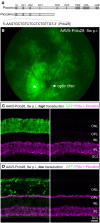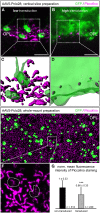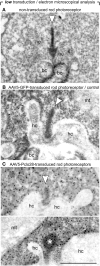In vivo knockdown of Piccolino disrupts presynaptic ribbon morphology in mouse photoreceptor synapses
- PMID: 25232303
- PMCID: PMC4153300
- DOI: 10.3389/fncel.2014.00259
In vivo knockdown of Piccolino disrupts presynaptic ribbon morphology in mouse photoreceptor synapses
Abstract
Piccolo is the largest known cytomatrix protein at active zones of chemical synapses. A growing number of studies on conventional chemical synapses assign Piccolo a role in the recruitment and integration of molecules relevant for both endo- and exocytosis of synaptic vesicles, the dynamic assembly of presynaptic F-actin, as well as the proteostasis of presynaptic proteins, yet a direct function in the structural organization of the active zone has not been uncovered in part due to the expression of multiple alternatively spliced isoforms. We recently identified Piccolino, a Piccolo splice variant specifically expressed in sensory ribbon synapses of the eye and ear. Here we down regulated Piccolino in vivo via an adeno-associated virus-based RNA interference approach and explored the impact on the presynaptic structure of mouse photoreceptor ribbon synapses. Detailed immunocytochemical light and electron microscopical analysis of Piccolino knockdown in photoreceptors revealed a hitherto undescribed photoreceptor ribbon synaptic phenotype with striking morphological changes of synaptic ribbon ultrastructure.
Keywords: Aczonin; Piccolino; Piccolo; RIBEYE; active zone; retina; ribbon synapse.
Figures








Similar articles
-
A Multiple Piccolino-RIBEYE Interaction Supports Plate-Shaped Synaptic Ribbons in Retinal Neurons.J Neurosci. 2019 Apr 3;39(14):2606-2619. doi: 10.1523/JNEUROSCI.2038-18.2019. Epub 2019 Jan 29. J Neurosci. 2019. PMID: 30696732 Free PMC article.
-
Identification and immunocytochemical characterization of Piccolino, a novel Piccolo splice variant selectively expressed at sensory ribbon synapses of the eye and ear.PLoS One. 2013 Aug 6;8(8):e70373. doi: 10.1371/journal.pone.0070373. Print 2013. PLoS One. 2013. PMID: 23936420 Free PMC article.
-
Early steps in the assembly of photoreceptor ribbon synapses in the mouse retina: the involvement of precursor spheres.J Comp Neurol. 2009 Feb 20;512(6):814-24. doi: 10.1002/cne.21915. J Comp Neurol. 2009. PMID: 19067356
-
Presynaptic [Ca(2+)] and GCAPs: aspects on the structure and function of photoreceptor ribbon synapses.Front Mol Neurosci. 2014 Feb 6;7:3. doi: 10.3389/fnmol.2014.00003. eCollection 2014. Front Mol Neurosci. 2014. PMID: 24567702 Free PMC article. Review.
-
Molecular organization and assembly of the presynaptic active zone of neurotransmitter release.Results Probl Cell Differ. 2006;43:49-68. doi: 10.1007/400_012. Results Probl Cell Differ. 2006. PMID: 17068967 Review.
Cited by
-
Role of Ribeye PXDLS/T-binding cleft in normal synaptic ribbon function.bioRxiv [Preprint]. 2023 Dec 12:2023.12.12.571266. doi: 10.1101/2023.12.12.571266. bioRxiv. 2023. PMID: 38168344 Free PMC article. Preprint.
-
Current concepts in cochlear ribbon synapse formation.Synapse. 2019 May;73(5):e22087. doi: 10.1002/syn.22087. Epub 2019 Feb 18. Synapse. 2019. PMID: 30592086 Free PMC article. Review.
-
Metabotropic Glutamate Receptors at Ribbon Synapses in the Retina and Cochlea.Cells. 2022 Mar 24;11(7):1097. doi: 10.3390/cells11071097. Cells. 2022. PMID: 35406660 Free PMC article. Review.
-
Vertebrate Presynaptic Active Zone Assembly: a Role Accomplished by Diverse Molecular and Cellular Mechanisms.Mol Neurobiol. 2018 Jun;55(6):4513-4528. doi: 10.1007/s12035-017-0661-9. Epub 2017 Jul 6. Mol Neurobiol. 2018. PMID: 28685386 Review.
-
Synaptic vesicle release during ribbon synapse formation of cone photoreceptors.Front Cell Neurosci. 2022 Nov 4;16:1022419. doi: 10.3389/fncel.2022.1022419. eCollection 2022. Front Cell Neurosci. 2022. PMID: 36406751 Free PMC article.
References
-
- Adly M. A., Spiwoks-Becker I., Vollrath L. (1999). Ultrastructural changes of photoreceptor synaptic ribbons in relation to time of day and illumination. Invest. Ophthalmol. Vis. Sci. 40, 2165–2172 - PubMed
Grants and funding
LinkOut - more resources
Full Text Sources
Other Literature Sources

